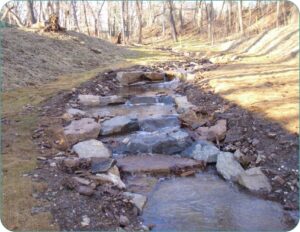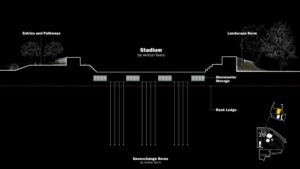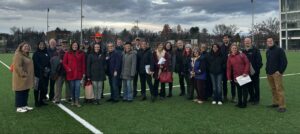The Green Infrastructure Committee’s Tour of Princeton University’s Stormwater Management Infrastructure
Photo courtesy of New Jersey Future.
On December 4, 2023, the Green Infrastructure Committee visited Princeton University to learn more about the great stormwater management planning and infrastructure they have built over the past 15+ years. Nitsch Engineering, the University’s stormwater management engineers, kicked off the visit with a presentation which was brought to life by the walking tour around campus.
Princeton University has been proactive in its stormwater planning and implementation since 2006, when they first began their efforts to increase the areas of campus under enhanced stormwater management. They re-affirmed that commitment with the adoption of the University’s 2019 Sustainability Action Plan and through their second Campus Stormwater Plan, adopted in 2017 as part of the 2026 Campus Plan. The Campus Stormwater Plan takes a comprehensive approach to building resilience and improving the health of the watershed. The plan uses green infrastructure and other technologies at both the site- and district-scale. So far, Princeton’s stormwater planning has guided the incremental installation of green infrastructure for dozens of capital projects. This has resulted in widespread green infrastructure across more than 100 acres of the campus in the Municipality of Princeton and 85 acres in West Windsor Township.
During the Green Infrastructure meeting, committee members got to see some of the technologies in place. The first stop on the tour was Poe/Pardee Fields, a recreational open space situated between three residential colleges on the southern part of Princeton’s central campus. The area is currently under construction for the installation of a regional, sub-surface
infiltration stormwater management system, integrated with a geo-exchange system. The regional infiltration basin was designed to provide capacity to meet the Campus Stormwater Plan goals and regulatory requirements.

Poe and Pardee fields under construction.
We then walked over Streicker Bridge to look down toward the Washington Road Stream, where approximately 1,400 linear feet of stream channel was restored and the woodland buffer to the adjacent Washington Road was expanded. Adjacent to the stream corridor is the Frick Chemistry Laboratory building. Completed in 2010, Frick was designed to exceed the stormwater management regulations in effect at the time and served as a pilot project for the implementation of green infrastructure. In addition to reducing impervious area by more than an acre (15 %), the project included site-scale technologies such as bioretention basins and a rainwater harvesting system.

Washington Road stream restoration.
Our next stop was the University’s athletics fields, starting with the soccer practice field, a synthetic turf field with a sizeable subsurface infiltration system toward the south end. This system exceeds regulatory capacity requirements and serves as a credit to the University’s Green Infrastructure Mitigation Bank. The University has installed monitoring equipment to record data on the infiltration rates of the system and is proud to report that to date, 100% of the water that has entered the subsurface infiltration system has completely infiltrated the ground below the field.
We then traveled to the top of the University’s Stadium Drive Garage for a bird’s eye view of the new soccer stadium. Another district-scale system was built under the stadium to support the “Stadium Neighborhood” and was designed to manage large storm events. The subsurface detention system beneath the soccer stadium provides approximately 80,000 cubic feet of mitigation capacity for large storm events. This regional system manages treated, excess stormwater from green infrastructure systems installed in projects currently in construction and planned for the future. They noted that, as this subsurface detention facility was approved and constructed prior to the Stormwater Management Rule that went into effect in March 2021, any future projects that use this system will require a green infrastructure waiver or variance.
The soccer stadium is also the site of an innovative, large-scale, geo-exchange system –combining two major resiliency infrastructure systems in one location. Co-locating the district-scale detention basin and the geo-exchange systems required a complex, “layered” design approach and an intense, collaborative, integrated design process.

Layered land uses at the field.
Surrounding the soccer facilities are localized green infrastructure installations. The landscaping along the street and parking garage includes bioretention planters, sub-surface infiltration systems, and landscape-based stormwater treatment areas. The nearby TIGER plant, which houses the geo-exchange utility facilities, also has these installations.

Roadside bioretention green infrastructure.
To date, Princeton reported that the strategies implemented across campus have contributed to reducing annual runoff by approximately 23 million gallons (35 %), while improving the quality of remaining runoff. The Campus Plan includes stormwater management efforts on every capital project. The Sustainability Action Plan has a goal of 222 acres of enhanced stormwater management by 2046.
Moving forward, the University understands that green infrastructure-based stormwater management is an essential first task for project teams as they plan for and design future capital projects. They are committed to assessing the effects of their current practices, making changes as needed to comply with changing regulations, continuing to provide enhanced stormwater management on campus, and collaborating with partners from across the state on best practices.
Thank you to Princeton for hosting our December meeting and tour, and for your leadership on stormwater management.

JWW Green Infrastructure Committee and Princeton University staff